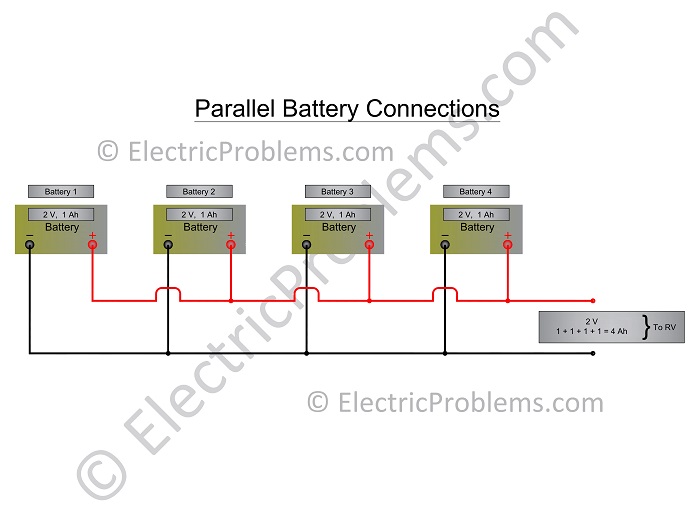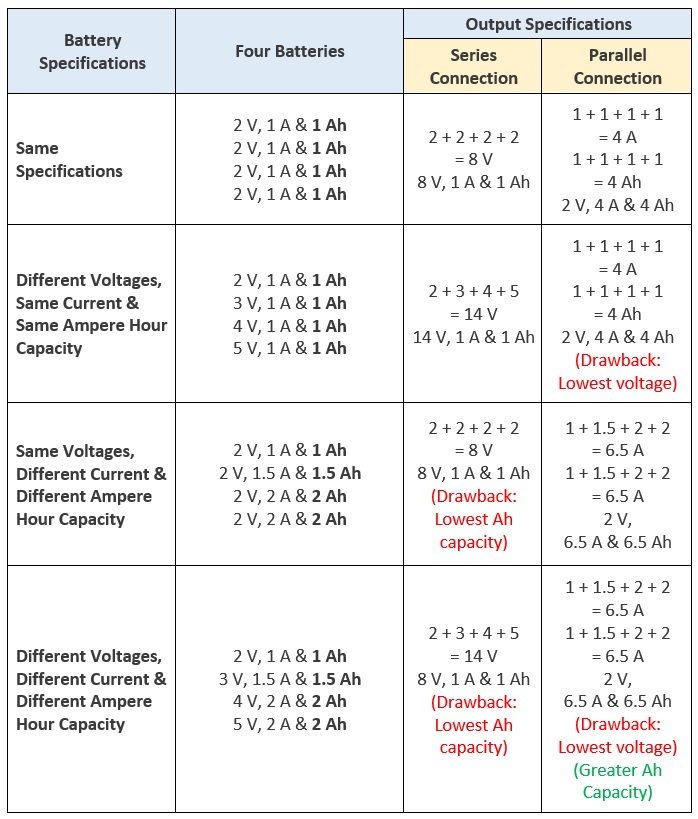![]()
RV Battery Bank [w/ Wiring Diagrams in PDF]
Once you have an inverter and interconnected solar panels, the next thing you need to do is to set up is an appropriate battery bank for storing your solar energy. In an RV, the power storage capacity is a big consideration. The power usage time is increased when the storage capacity is increased.
To increase the storage capacity, we must add the number of batteries together to form a battery bank. The best performance of the battery bank is achieved if we connect the batteries with the same specifications (same voltage, same current, and same Ampere Hours).
To add multiple batteries, we have two ways to connect them:
- In series
- In parallel
Each connection type has its own pros and cons:
Series battery Connections
In the series connection type, we connect:
- The positive (red) terminal of one battery to the negative (black) terminal of the second battery,
- Again, the positive (red) terminal of the second battery to the negative (black) terminal of the third battery, and so on.
- Finally, the positive (red) terminal of the last battery and the negative (black) terminal of the first battery will serve as the output terminals.
This is how all batteries in the series are connected.
1. Series Battery connections (same specifications)
In this method, the voltage of all individual batteries adds up while current and ampere-hour capacity remains the same. Let’s take an example of four batteries each has 2 V, 1 Amps current, and 1 Ah capacity.
- Battery #1: 2 V, 1 A, 1 Ah
- Battery #2: 2 V, 1 A, 1 Ah
- Battery #3: 2 V, 1 A, 1 Ah
- Battery #4: 2 V, 1 A, 1 Ah
If we connect them in series, then the voltage adds up to 8 V (2 + 2 + 2 + 2 = 8 V), while the current remains 1 Amp. Also, the Ampere Hour capacity remains 1 Ah.
 Download PDF
Download PDF
2. Series Battery connections (different voltages & same current) (same Ampere Hours)
Different voltage batteries can be connected in series as well and here is an example of four different batteries:
- Battery #1: 2 V, 1 A, 1 Ah
- Battery #2: 3 V, 1 A, 1 Ah
- Battery #3: 4 V, 1 A, 1 Ah
- Battery #4: 5 V, 1 A, 1 Ah
After connecting them in series, the voltage adds up to 14 V (2 + 3 + 4 + 5 = 14 V), but the current and the capacity remain the same (1 Ampere and 1 Ampere Hour).
3. Series Battery connections (same voltages & different current) (different Ampere Hours)
Here is an example of the batteries to be connected in series that have the same voltage, different current, and different Ampere Hour capacity:
- Battery #1: 2 V, 1 A, 1 Ah
- Battery #2: 2 V, 1.5 A, 1.5 Ah
- Battery #3: 2 V, 2 A, 2 Ah
- Battery #4: 2 V, 2 A, 2 Ah
When we connect these batteries in series, then the voltage adds up to 8 V (2 + 2 + 2 + 2 = 8 V). Current and Ampere Hour capacity will stick to the lowest value of 1 A and 1 Ah.
4. Series Battery connections (different voltages & different current) (different Ampere Hours)
We can also connect batteries that have different voltages and different current ratings in series. For example, if we have four batteries like:
- Battery #1: 2 V, 1 A, 1 Ah
- Battery #2: 3 V, 1.5 A, 1.5 Ah
- Battery #3: 4 V, 2 A, 2 Ah
- Battery #4: 5 V, 2 A, 2 Ah
… then, we can connect them in series and the voltage adds up to 14 V (2 + 3 + 4 + 5 = 14 V). The current and the capacity will be respectively at 1 A and 1 Ah (because it is the lowest value).
Parallel battery Connections
The general rule for parallel connections is:
When several batteries are connected in parallel then the current adds up while the voltage remains the same.
Now, let’s look at connections:
1. Parallel Battery connections (same specifications)
To wire batteries in a parallel manner we must connect:
- All positive (red) terminals of batteries together.
- All negative (black) terminals together.
These two terminals will behave as the positive (red) terminal and negative (black) terminal of the battery bank. For example, our battery bank consists of:
- Battery #1: 2 V, 1 A, 1 Ah
- Battery #2: 2 V, 1 A, 1 Ah
- Battery #3: 2 V, 1 A, 1 Ah
- Battery #4: 2 V, 1 A, 1 Ah
After connecting them in parallel, the current adds up to 4 A (1 + 1 + 1 + 1 = 4 A) and the capacity to 4 Ah (1 + 1 + 1 + 1 = 4 Ah), while voltage remains 2 V.
 Download PDF
Download PDF
2. Parallel Battery connections (different voltages & same current) (same Ampere Hours)
If your batteries are of different voltages, you can still parallel them together. Here is our example of four batteries:
- Battery #1: 2 V, 1 A, 1 Ah
- Battery #2: 3 V, 1 A, 1 Ah
- Battery #3: 4 V, 1 A, 1 Ah
- Battery #4: 5 V, 1 A, 1 Ah
In this situation, the current adds up to 4 A (1 + 1 + 1 + 1 = 4 A), as well as Ampere Hour capacity and in this case it will be 4 Ah (1 + 1 + 1 + 1 = 4 Ah). The voltage of this battery bank will be the lowest value of all batteries (in this case it is 2 V).
3. Parallel Battery connections (same voltages & different currents) (different Ampere Hours)
If we have four batteries with same voltage and different currents like:
- Battery #1: 2 V, 1 A, 1 Ah
- Battery #2: 2 V, 1.5 A, 1.5 Ah
- Battery #3: 2 V, 2 A, 2 Ah
- Battery #4: 2 V, 2 A, 2 Ah
… then, after connecting the wires, the battery bank shows 2 V, 6.5 A current (1 + 1.5 + 2 + 2 = 6.5 A) and 6.5 Ah capacity (1 + 1.5 + 2 + 2 = 6.5 Ah). In this case, the current ratings and Ah capacity adds up.
4. Parallel Battery connections (different voltages & different currents) (different Ampere Hours)
In the next example we have four batteries but this time these all have different voltages, different current ratings, and different Ampere Hour capacities.
- Battery #1: 2 V, 1 A, 1 Ah
- Battery #2: 3 V, 1.5 A, 1.5 Ah
- Battery #1: 3 V, 2 A, 2 Ah
- Battery #1: 4 V, 2 A, 2 Ah
As we connect these batteries in parallel, the current of all batteries is added and becomes 6.5 A (1 + 1.5 + 2 + 2 = 6.5 A) and capacity becomes 6.5 Ah (1 + 1.5 + 2 + 2 = 6.5 Ah). The voltage remains to the lowest of all battery’s voltages and in this case, it is 2 V.
Now, let’s look at the comparison tables of the battery connections.
Compare series connections:
| Four Solar Panels | Series Connection |
| 2 V, 1 A & 1 Ah
2 V, 1 A & 1 Ah 2 V, 1 A & 1 Ah 2 V, 1 A & 1 Ah |
Same Specifications
2 + 2 + 2 + 2 = 8 V 8 V, 1 A & 1 Ah |
| 2 V, 1 A & 1 Ah
3 V, 1 A & 1 Ah 4 V, 1 A & 1 Ah 5 V, 1 A & 1 Ah |
Different Voltages, Same Current & Same Ampere Hour Capacity
2 + 3 + 4 + 5 = 14 V 14 V, 1 A & 1 Ah
|
| 2 V, 1 A & 1 Ah
2 V, 1.5 A & 1.5 Ah 2 V, 2 A & 2 Ah 2 V, 2 A & 2 Ah |
Same Voltages, Different Current & Different Ampere Hour Capacity
2 + 2 + 2 + 2 = 8 V 8 V, 1 A & 1 Ah (Drawback: Lowest Ah capacity) |
| 2 V, 1 A & 1 Ah
3 V, 1.5 A & 1.5 Ah 4 V, 2 A & 2 Ah 5 V, 2 A & 2 Ah |
Different Voltages, Different Current & Different Ampere Hour Capacity
2 + 3 + 4 + 5 = 14 V 8 V, 1 A & 1 Ah (Drawback: Lowest Ah capacity) |
Compare parallel connections:
| Four Solar Panels | Series Connection |
| 2 V, 1 A & 1 Ah
2 V, 1 A & 1 Ah 2 V, 1 A & 1 Ah 2 V, 1 A & 1 Ah |
Same Specifications
1 + 1 + 1 + 1 = 4 A 1 + 1 + 1 + 1 = 4 Ah 2 V, 4 A & 4 Ah |
| 2 V, 1 A & 1 Ah
3 V, 1 A & 1 Ah 4 V, 1 A & 1 Ah 5 V, 1 A & 1 Ah |
Different Voltages, Same Current & Same Ampere Hour Capacity
1 + 1 + 1 + 1 = 4 A 1 + 1 + 1 + 1 = 4 Ah 2 V, 4 A & 4 Ah (Drawback: Lowest voltage) |
| 2 V, 1 A & 1 Ah
2 V, 1.5 A & 1.5 Ah 2 V, 2 A & 2 Ah 2 V, 2 A & 2 Ah |
Same Voltages, Different Current & Different Ampere Hour Capacity
1 + 1.5 + 2 + 2 = 6.5 A 1 + 1.5 + 2 + 2 = 6.5 A 2 V, 6.5 A & 6.5 Ah |
| 2 V, 1 A & 1 Ah
3 V, 1.5 A & 1.5 Ah 4 V, 2 A & 2 Ah 5 V, 2 A & 2 Ah |
Different Voltages, Different Current & Different Ampere Hour Capacity
1 + 1.5 + 2 + 2 = 6.5 A 1 + 1.5 + 2 + 2 = 6.5 A 2 V, 6.5 A & 6.5 Ah (Drawback: Lowest voltage) (Advantage: Greater Ah Capacity) |
Compare series to parallel connections:
Let’s look at some key points based on the above table:
- To get the maximum power storage capacity, the best approach is to use batteries of the same ratings (same voltage and same ampere-hour ratings).
- If we have batteries with different specifications (such as different voltages & the same ampere-hour capacity), then it is better to use a series connection approach. This will give greater output voltage.
- If the batteries have the same voltages & different ampere-hour capacity, then it is better to use a parallel connection approach to get maximum ampere-hour capacity.
- The worst case is if we have solar panels which have different voltages & different ampere-hour capacity. If this is what you have, then you should use a “parallel connection” approach because it has more ampere-hour capacity than “series connections”.
Combined battery Connections
In these types of connections, we combine both series and parallel connection techniques. This technique is more favorable for a bigger storage capacity.
1. Series-Parallel battery connections
In series-parallel battery connections, we first combine batteries in series to make smaller battery banks. In this way, as the batteries are connected in series then the voltages of all individual batteries are added up while the ampere-hour capacity remains the same.
Then we connect all battery banks in parallel. After connecting them to parallel the voltage remains the same while the ampere-hour capacity is added up.
For example, let’s say we have eight batteries 3 V and 100 Ah each.
First, we connect batteries 1 – 4 in series to make series bank #1. The output of series bank #1 is:
3 + 3 + 3 + 3 = 12V, 100 Ah
Second, we connect batteries 5 – 8 in series to make series bank #2. The output is:
3 + 3 + 3 + 3 = 12V, 100 Ah
Finally, we connect the two battery banks in parallel. Now the voltage remains the same while ampere-hour capacity is added up to 200 Ah (100 + 100 = 200 Ah). The output is:
12 V, 200 Ah.
We can add more series of banks to this parallel connection in order to increase the ampere-hour capacity (300 Ah, 400 Ah, etc)
 Download PDF
Download PDF
2. Parallel-Series battery connections
In parallel-series battery connections, we connect several batteries in parallel to make a parallel bank. In this way, the voltage of the parallel bank remains the same as the individual battery while the ampere-hour capacity is added up.
Then repeat the same procedure for other parallel banks.
Finally, we connect all parallel banks in series. By doing this the voltage of each parallel bank is added up while the ampere-hour capacity remains the same as the individual parallel bank.
For example, we have eight batteries 3 V and 100 Ah each. We connect batteries 1 – 4 in parallel to make parallel bank #1. The ampere-hour capacity added up to 400 Ah:
100 + 100 + 100 + 100 = 400 Ampere Hour
The output of this parallel bank #1 is:
3 V, 400 Ah
Similarly, for parallel bank#2 we connect batteries 5 – 8 in parallel. The output of parallel bank #2 is:
3 V, 400 Ah
You can make as many parallel banks as you need. Finally, we connect all parallel banks in series. Now the voltage of all parallel banks is added up like and in this case, it is 6 V.
3 + 3 = 6 V
While the ampere-hour capacity remains the same as the individual parallel bank of 400 Ah, the output is:
6 V, 400 Ah
We can increase the voltage by adding more parallel banks.
 Download PDF
Download PDF
Here is a comparison table of series-parallel connection and parallel-series connection (the same number of batteries is used for both types of connections):
| 2 Banks (4 Batteries Each) | Each Battery Bank | Total Output |
| 3 V, 100 Ah
3 V, 100 Ah 3 V, 100 Ah 3 V, 100 Ah X 2 |
3 + 3 + 3 + 3 = 12 V
12V, 100 Ah |
Series-Parallel Connection Output
100 + 100 = 200 Ah 12 V, 200 Ah |
| 3 V, 100 Ah
3 V, 100 Ah 3 V, 100 Ah 3 V, 100 Ah X 2 |
100 + 100 + 100 + 100 = 400 Ampere hour
3V, 400 Ah |
Parallel-Series Connection Output
3 + 3 = 6 V 6 V, 400 Ah |
Once again, your battery bank wiring really comes down to how much power you need and what kind of batteries you have on hand (or plan to purchase). To complete RV wiring, you may also want to take a look at the article on inverter wiring (with diagrams) and solar panel wiring (with diagrams as well).
Here is a good, informative video on solar and battery sizing:

Click on the white button above to find your electrician!




